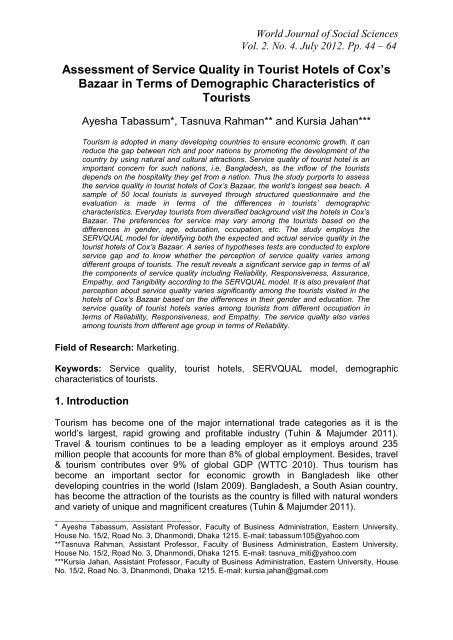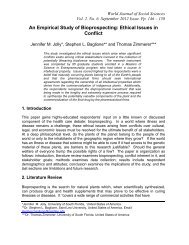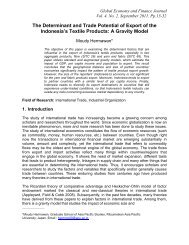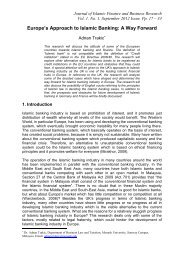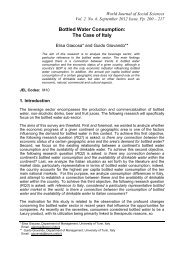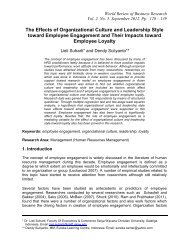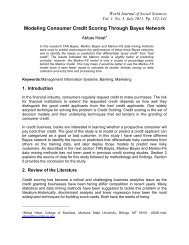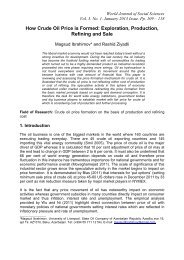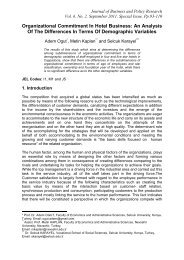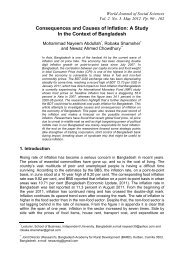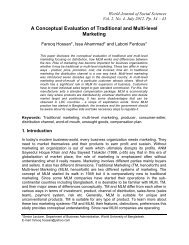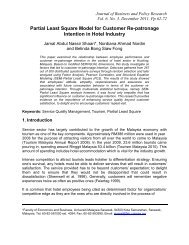Assessment of Service Quality in Tourist Hotels of ... - Wbiaus.org
Assessment of Service Quality in Tourist Hotels of ... - Wbiaus.org
Assessment of Service Quality in Tourist Hotels of ... - Wbiaus.org
You also want an ePaper? Increase the reach of your titles
YUMPU automatically turns print PDFs into web optimized ePapers that Google loves.
World Journal <strong>of</strong> Social SciencesVol. 2. No. 4. July 2012. Pp. 44 – 64<strong>Assessment</strong> <strong>of</strong> <strong>Service</strong> <strong>Quality</strong> <strong>in</strong> <strong>Tourist</strong> <strong>Hotels</strong> <strong>of</strong> Cox’sBazaar <strong>in</strong> Terms <strong>of</strong> Demographic Characteristics <strong>of</strong><strong>Tourist</strong>sAyesha Tabassum*, Tasnuva Rahman** and Kursia Jahan***Tourism is adopted <strong>in</strong> many develop<strong>in</strong>g countries to ensure economic growth. It canreduce the gap between rich and poor nations by promot<strong>in</strong>g the development <strong>of</strong> thecountry by us<strong>in</strong>g natural and cultural attractions. <strong>Service</strong> quality <strong>of</strong> tourist hotel is animportant concern for such nations, i.e. Bangladesh, as the <strong>in</strong>flow <strong>of</strong> the touristsdepends on the hospitality they get from a nation. Thus the study purports to assessthe service quality <strong>in</strong> tourist hotels <strong>of</strong> Cox’s Bazaar, the world’s longest sea beach. Asample <strong>of</strong> 50 local tourists is surveyed through structured questionnaire and theevaluation is made <strong>in</strong> terms <strong>of</strong> the differences <strong>in</strong> tourists’ demographiccharacteristics. Everyday tourists from diversified background visit the hotels <strong>in</strong> Cox’sBazaar. The preferences for service may vary among the tourists based on thedifferences <strong>in</strong> gender, age, education, occupation, etc. The study employs theSERVQUAL model for identify<strong>in</strong>g both the expected and actual service quality <strong>in</strong> thetourist hotels <strong>of</strong> Cox’s Bazaar. A series <strong>of</strong> hypotheses tests are conducted to exploreservice gap and to know whether the perception <strong>of</strong> service quality varies amongdifferent groups <strong>of</strong> tourists. The result reveals a significant service gap <strong>in</strong> terms <strong>of</strong> allthe components <strong>of</strong> service quality <strong>in</strong>clud<strong>in</strong>g Reliability, Responsiveness, Assurance,Empathy, and Tangibility accord<strong>in</strong>g to the SERVQUAL model. It is also prevalent thatperception about service quality varies significantly among the tourists visited <strong>in</strong> thehotels <strong>of</strong> Cox’s Bazaar based on the differences <strong>in</strong> their gender and education. Theservice quality <strong>of</strong> tourist hotels varies among tourists from different occupation <strong>in</strong>terms <strong>of</strong> Reliability, Responsiveness, and Empathy. The service quality also variesamong tourists from different age group <strong>in</strong> terms <strong>of</strong> Reliability.Field <strong>of</strong> Research: Market<strong>in</strong>g.Keywords: <strong>Service</strong> quality, tourist hotels, SERVQUAL model, demographiccharacteristics <strong>of</strong> tourists.1. IntroductionTourism has become one <strong>of</strong> the major <strong>in</strong>ternational trade categories as it is theworld’s largest, rapid grow<strong>in</strong>g and pr<strong>of</strong>itable <strong>in</strong>dustry (Tuh<strong>in</strong> & Majumder 2011).Travel & tourism cont<strong>in</strong>ues to be a lead<strong>in</strong>g employer as it employs around 235million people that accounts for more than 8% <strong>of</strong> global employment. Besides, travel& tourism contributes over 9% <strong>of</strong> global GDP (WTTC 2010). Thus tourism hasbecome an important sector for economic growth <strong>in</strong> Bangladesh like otherdevelop<strong>in</strong>g countries <strong>in</strong> the world (Islam 2009). Bangladesh, a South Asian country,has become the attraction <strong>of</strong> the tourists as the country is filled with natural wondersand variety <strong>of</strong> unique and magnificent creatures (Tuh<strong>in</strong> & Majumder 2011).___________________________* Ayesha Tabassum, Assistant Pr<strong>of</strong>essor, Faculty <strong>of</strong> Bus<strong>in</strong>ess Adm<strong>in</strong>istration, Eastern University,House No. 15/2, Road No. 3, Dhanmondi, Dhaka 1215. E-mail: tabassum105@yahoo.com**Tasnuva Rahman, Assistant Pr<strong>of</strong>essor, Faculty <strong>of</strong> Bus<strong>in</strong>ess Adm<strong>in</strong>istration, Eastern University,House No. 15/2, Road No. 3, Dhanmondi, Dhaka 1215. E-mail: tasnuva_miti@yahoo.com***Kursia Jahan, Assistant Pr<strong>of</strong>essor, Faculty <strong>of</strong> Bus<strong>in</strong>ess Adm<strong>in</strong>istration, Eastern University, HouseNo. 15/2, Road No. 3, Dhanmondi, Dhaka 1215. E-mail: kursia.jahan@gmail.com
Tabassum, Rahman & JahanMoreover, Bangladesh has archaeological, ecological, cultural and other tourismproducts to attract tourists (Tuh<strong>in</strong> & Majumder 2011). Apart from a country’s beautifulnatural environment, the warmth welcome <strong>of</strong> local population and tourist’smemorable souvenirs are deeply <strong>in</strong>fluenced by the type <strong>of</strong> service they receive fromthe hotel where they lodge (Fowdar 2007). Therefore tourist hotels should strive fordeliver<strong>in</strong>g quality services to ensure customer satisfaction, which by turn ensuressurvival and pr<strong>of</strong>itability <strong>of</strong> these hotels (Fowdar 2007). In recent years, customershave become <strong>in</strong>creas<strong>in</strong>gly more sensitive to service quality (Lee & H<strong>in</strong>g 1995). Thussatisfy<strong>in</strong>g these quality conscious customers can be possible by provid<strong>in</strong>g qualityservices. There has been evidence that when customers’ perceptions <strong>of</strong> servicequality are positive, the behavioral <strong>in</strong>tentions are favorable; this strengthens theirrelationship with the <strong>org</strong>anization (Zeithaml & Bitner 2003). On the other hand, whenservice quality assessments are negative, the customers’ behavioral <strong>in</strong>tentions areunfavorable (Kouthouris & Alexandris 2005). Thus quality is becom<strong>in</strong>g critical <strong>in</strong> theservice <strong>org</strong>anizations as services are becom<strong>in</strong>g more commodity-like (Chowdhury,Iqbal & Miah 2010). Through quality services, the <strong>org</strong>anizations can differentiate <strong>in</strong>the market and satisfy the customer needs (Ozment & Morash 1994). Moreover,research has demonstrated the strategic benefits <strong>of</strong> quality <strong>in</strong> contribut<strong>in</strong>g to marketshare and ROI, as well as lower<strong>in</strong>g manufactur<strong>in</strong>g costs and improv<strong>in</strong>g productivity(Anderson & Zeithaml 1984; Garv<strong>in</strong> 1982). That’s why deliver<strong>in</strong>g superior servicequality is a prerequisite for success and survival <strong>in</strong> today’s competitive bus<strong>in</strong>essenvironment (Gilbert & Wong 2006).The service managers and academic researchers are try<strong>in</strong>g to understand howcustomers perceive the quality <strong>of</strong> service, as the service <strong>in</strong>dustry has becomecompetitive. The tourist hotel is a typical service <strong>in</strong>dustry, <strong>of</strong>fer<strong>in</strong>g <strong>in</strong>dividual servicesfor tourists (Tsaur, Chang & Wu 2004). Like any other service <strong>in</strong>dustry, customersatisfaction and loyalty are secured through high quality services <strong>in</strong> this <strong>in</strong>dustry.<strong>Tourist</strong>s usually judge their accommodation based on the evaluation <strong>of</strong> <strong>in</strong>teractions,hotel environment and the value associated with stay<strong>in</strong>g at the place <strong>of</strong>accommodation (Haghkhah, Nosratpour, Ebrahimpour & Hamid 2011). This papertakes a first step towards explor<strong>in</strong>g the service quality <strong>of</strong> tourist hotels <strong>in</strong> Cox’sBazaar. Even, Bangladesh Parjatan Corporation, the <strong>of</strong>ficial authority <strong>of</strong> tourism<strong>in</strong>dustry did not take any <strong>in</strong>terest <strong>in</strong> measur<strong>in</strong>g the service quality. The reason beh<strong>in</strong>dsuch scenario may be the fact that Bangladesh has recently realized the contribution<strong>of</strong> service sector <strong>in</strong> economic development. Thus like other service <strong>in</strong>dustries, noresearch <strong>in</strong>itiative is taken so far to explore the service quality <strong>of</strong> these tourist hotels<strong>in</strong> terms <strong>of</strong> customer expectation and actual service quality <strong>in</strong> Bangladesh. Besideslack <strong>of</strong> research <strong>in</strong>terests, as the necessary supportive requirements for researchesare not adequate <strong>in</strong> the country, very few service <strong>in</strong>dustries are explored <strong>in</strong> terms <strong>of</strong>service quality.This research paper focuses on the l<strong>in</strong>k between tourist expectations and servicequality, and demonstrates the measure <strong>of</strong> different tourists’ expectations as adiagnostic tool <strong>in</strong> manag<strong>in</strong>g its service quality. It is found <strong>in</strong> previous researches thatthe customer expectations construct has been viewed as play<strong>in</strong>g a key role <strong>in</strong> theevaluation <strong>of</strong> service quality (Gro¨nroos 1994; Parasuraman, Zeithaml, & Berry 1985,1988). Such approaches have been previously researched <strong>in</strong> different fields <strong>of</strong>bus<strong>in</strong>ess (Gilbert & Wong 2006; Gustafsson & Johnson 2004; Bebko 2000). Besidesdemographic characteristics is one <strong>of</strong> the major determ<strong>in</strong>ants <strong>of</strong> consumer buy<strong>in</strong>gbehavior and it plays a noteworthy role <strong>in</strong> shap<strong>in</strong>g customer needs (Aksoy, Atilgan &45
Tabassum, Rahman & JahanAk<strong>in</strong>ci 2003). In fact differences <strong>in</strong> the demographic pr<strong>of</strong>ile <strong>of</strong> the customers can leadto variances <strong>in</strong> the expectations regard<strong>in</strong>g service quality (Bebko 2000). That’s why<strong>in</strong> this study the attempt was made to extract the root causes affect<strong>in</strong>g the servicequality <strong>of</strong> the tourist hotels <strong>of</strong> Bangladesh and the expectations <strong>of</strong> different types <strong>of</strong>tourists based on their demographic differences towards the improvement <strong>of</strong> quality<strong>of</strong> hotel services that will <strong>of</strong>fer them a competitive edge.2. Objectives <strong>of</strong> the StudyThe ma<strong>in</strong> objective <strong>of</strong> this study is to assess the service quality <strong>of</strong> the tourist hotels <strong>in</strong>Cox’s Bazaar <strong>of</strong> Bangladesh based on the differences <strong>in</strong> demographiccharacteristics <strong>of</strong> the tourists. More specifically the objectives <strong>of</strong> the study are:• To f<strong>in</strong>d out the expectations <strong>of</strong> tourists regard<strong>in</strong>g service quality andperceptions about the actual service quality <strong>in</strong> the tourist hotels <strong>of</strong>Bangladesh.• To identify the gap between the expected and actual service quality <strong>in</strong> thetourist hotels <strong>of</strong> Bangladesh.• To f<strong>in</strong>d out whether the tourists’ perceptions vary across gender or not.• To f<strong>in</strong>d out whether the tourists’ perceptions vary across their different levels<strong>of</strong> age or not.• To f<strong>in</strong>d out whether the tourists’ perceptions vary across the different types <strong>of</strong>occupations or not.• To f<strong>in</strong>d out whether the tourists’ perceptions vary across their different levels<strong>of</strong> education or not.3. Literature Review3.1 Tourism Industry and <strong>Tourist</strong> <strong>Hotels</strong> <strong>in</strong> BangladeshNow-a-days tourism is considered as the largest and rapid grow<strong>in</strong>g <strong>in</strong>dustry <strong>of</strong>modern bus<strong>in</strong>ess world. Today tourism is the most advantageous and up-to-datebus<strong>in</strong>ess all over the world (Tuh<strong>in</strong> & Majumder 2011). For many develop<strong>in</strong>gcountries it is one <strong>of</strong> the ma<strong>in</strong> <strong>in</strong>come sources. Accord<strong>in</strong>g to Bangladesh Bank(2011), the foreign exchange earn<strong>in</strong>gs from tourism and other travels is 5562.70million Tk. <strong>in</strong> 2010. Tourism, mostly a service <strong>in</strong>dustry, is more labor oriented thanother sectors <strong>of</strong> production. Thus, <strong>in</strong> view <strong>of</strong> the fact that Bangladesh has a labor<strong>in</strong>tensiveeconomy the creation <strong>of</strong> more employment opportunities for the grow<strong>in</strong>gpopulation is crucial. Therefore, tourism <strong>in</strong>dustry can create employmentopportunities and a productive labor force to a greater degree than other sectors(Tuh<strong>in</strong> & Majumder 2011). For this purpose, Bangladesh tourism <strong>in</strong>dustry shouldarrange its market<strong>in</strong>g mix elements <strong>in</strong> a way that atta<strong>in</strong> positive attitudes <strong>of</strong> theforeign tourists and ensure growth <strong>of</strong> the country (Hossa<strong>in</strong>, Khan & Hasan 2005).Tourism <strong>in</strong>dustry <strong>in</strong> Bangladesh still has not got a solid foot<strong>in</strong>g to “taken <strong>of</strong>f” despiteall the efforts and measures from government and other private agencies (Ahmed1986). This is because people have country specific attract<strong>in</strong>g and repell<strong>in</strong>g factorswhich affect tourists’ choice and decision regard<strong>in</strong>g their travel to a country (Tuh<strong>in</strong> &Majumder 2011). So, promotion <strong>of</strong> tourism <strong>of</strong> a country is greatly dependent on themagnitude <strong>of</strong> publicity. Therefore, it became imperative for the government to comeforward by promote tourism <strong>in</strong> Bangladesh (Talukder 1984).46
Tabassum, Rahman & JahanSoon after the <strong>in</strong>dependence <strong>of</strong> Bangladesh, the government <strong>of</strong> the newborn staterealized the importance <strong>of</strong> tourism <strong>in</strong> its economic and social life. Therefore, thegovernment decided to re<strong>org</strong>anize the tourism sector by comb<strong>in</strong><strong>in</strong>g both the tourismdepartment and the private corporation <strong>in</strong>to one <strong>org</strong>anization, br<strong>in</strong>g<strong>in</strong>g it undergovernment responsibility for better coord<strong>in</strong>ation, promotion, development andmarket<strong>in</strong>g (Hossa<strong>in</strong> & Nazm<strong>in</strong> 2006). Consequently, the government established theNational Tourism Organization (NTO) <strong>in</strong> the name <strong>of</strong> Bangladesh ParjatanCorporation under Presidential Order No. 143, declared <strong>in</strong> November 27, 1972. BPCbegan <strong>in</strong> January 1973 with limited assets <strong>of</strong> the former “Pakistan TourismCorporation” and TK.10 million ($US147,059) sanctioned by the government. TheCorporation was entrusted with the dual responsibility <strong>of</strong> develop<strong>in</strong>g tourism<strong>in</strong>frastructure and promot<strong>in</strong>g Bangladesh as a tourist dest<strong>in</strong>ation. Otherresponsibilities <strong>of</strong> the Corporation <strong>in</strong>cluded regulation and operation <strong>of</strong> tourismactivities <strong>in</strong> the country. Thus, Bangladesh Parjatan Corporation came <strong>in</strong>to be<strong>in</strong>g asthe NTO <strong>in</strong> Bangladesh (MoCAT 2011). The major problems <strong>of</strong> tourism <strong>in</strong>dustry <strong>in</strong>Bangladesh are over population, natural disasters, unemployment, and economicunderdevelopment (Hall & Page 2000). At present, there are a number <strong>of</strong> touristfacilities and tourist hotels <strong>in</strong> Bangladesh. But <strong>in</strong> some cases <strong>in</strong>formation <strong>of</strong> thesefacilities and hotels are not available to the tourists (Hasan 1992).3.2 <strong>Service</strong> <strong>Quality</strong> and SERVQUAL Model<strong>Quality</strong> refers to the ability <strong>of</strong> a product or service to consistently meet or exceedcustomer expectations (Stevenson 2002). Schoenberger (1990) found twelvedimensions that customers associate with quality products and services, although allthe dimensions <strong>of</strong> quality are not relevant to all products and services. Thesedimensions are: conformance to specification, performance, quick response, quickchangeexpertise, features, reliability, durability, serviceability, aesthetics, perceivedquality, humanity, and value. <strong>Quality</strong> is considered as the cornerstone <strong>of</strong> success forany bus<strong>in</strong>ess, as it is the key factor for the susta<strong>in</strong>able competitive advantages(Hampton 1993). For the success <strong>of</strong> any service <strong>org</strong>anization, quality is a critical and<strong>of</strong> paramount importance to service providers (Bebko 2000), as services are the<strong>in</strong>tangible outcomes <strong>of</strong> a tangible or <strong>in</strong>tangible process. Over the past several years,there have been a variety <strong>of</strong> studies on different issues perta<strong>in</strong><strong>in</strong>g to service quality.Traditionally service quality has been def<strong>in</strong>ed as the difference between thecustomer expectations <strong>of</strong> the service to be received and perception <strong>of</strong> the serviceactually received (Gro¨nroos 1984; Parasuraman, Zeithaml, & Berry 1985, 1988).These researchers posited that measur<strong>in</strong>g service quality as “disconfirmation” that isthe difference between perceptions and expectations, is valid. Thus such a modelallows service providers to identify certa<strong>in</strong> def<strong>in</strong>ed gaps <strong>in</strong> the service provided(Wang, Lo & Hui 2003).The <strong>in</strong>strument used to explore service quality <strong>in</strong> this study was adapted fromSERVQUAL model (Parasuraman, Zeithaml and Berry 1985, 1988). SERVQUALmodel is one <strong>of</strong> the first service quality models, measured service quality us<strong>in</strong>g theexpectancy disconfirmation framework on the five dimensions <strong>of</strong> tangibles,responsiveness, reliability, assurance, and empathy (Parasuraman, Zeithaml andBerry 1985, 1988). Parasuraman et al. (1988, 1991) found that the five-dimensionalformat <strong>of</strong> SERVQUAL allows researchers to assess the level <strong>of</strong> service quality alongeach dimension, as well as overall. The purpose <strong>of</strong> this model is to serve as a47
Tabassum, Rahman & Jahandiagnostic method for uncover<strong>in</strong>g broad areas <strong>of</strong> weaknesses and strengths <strong>in</strong> thequality <strong>of</strong> service an <strong>org</strong>anization delivers.The five dimensions <strong>of</strong> SERVQUAL model identified by Parasuraman et al. (1988)are:1. Reliability: Ability to perform the promised service dependably and accurately.2. Responsiveness: Will<strong>in</strong>gness to help customers and provide prompt service.3. Assurance: Employees’ knowledge and courtesy and their ability to <strong>in</strong>spire trustand confidence.4. Empathy: Car<strong>in</strong>g, <strong>in</strong>dividualized attention given to customer.5. Tangibles: Appearance <strong>of</strong> physical facility, equipment, personnel and writtenmaterials.Parasuraman et al. (1988) def<strong>in</strong>e five gaps from their research data:Gap 1. The discrepancy between customers’ expectations and management’sperceptions <strong>of</strong> these expectations.Gap 2. The discrepancy between management’s perceptions <strong>of</strong> customers’expectations and service quality specifications.Gap 3. The discrepancy between service quality specifications and actual servicedelivery.Gap 4. The discrepancy between actual service delivery and what is communicatedto customers about it.Gap 5. The discrepancy between customer’s expected service and perceived servicedelivered.The first four gaps contribute to Gap 5, that is, the gap between customerexpectations and customer perceptions <strong>of</strong> service received- and it is this last gapwhich has been the ma<strong>in</strong> focus <strong>of</strong> this research. The figure <strong>of</strong> the gaps <strong>of</strong>SERVQUAL Model is represented <strong>in</strong> Figure 1.48
Tabassum, Rahman & JahanFigure 1: Model <strong>of</strong> service quality gaps (Parasuraman et al., 1985).3.3 SERVQUAL Model <strong>in</strong> ResearchEven though the SERVQUAL model was used widely <strong>in</strong> researches, the model hascome under extensive criticism by market<strong>in</strong>g researchers (see Babakus & Boller1992; Carman 1990; Cron<strong>in</strong> & Taylor 1992; Brown et al. 1993; Cron<strong>in</strong> & Taylor 1992;Carman 1990). Accord<strong>in</strong>g to Markovic and Raspor (2010), “criticism was directed atthe conceptual and operational base <strong>of</strong> the model, mostly its validity, reliability,operationalization <strong>of</strong> expectations, and dimensional structure”. Though theSERVQUAL model has such numerous limitations, the model’s framework hasguided numerous studies <strong>in</strong> the service sector that focus on banks, repair andma<strong>in</strong>tenance services, telephone companies, physicians, hospitals, hotels, academic<strong>in</strong>stitutions and retail stores (Parasuraman et al. 1988; Carman 1990; Bould<strong>in</strong>g et al.1993; Kouthouris & Alexandris 2005). Several researchers have used SERVQUALmodel to measure service quality <strong>in</strong> tourism <strong>in</strong>dustry (Augustyn & Ho 1998; Fick &Ritchie 1991; Avci & Nadiri 2000; Antilgan, Ak<strong>in</strong>ci & Aksoy 2003). In Bangladesh theSERVQUAL model has been used to measure the service gap <strong>in</strong> different <strong>in</strong>dustriessuch as, private universities (Chowdhury, Iqbal and Miah 2010), retail stores (Khan &Jahan, 2011), advertisement agencies (Khan 2010), SME, retail bank<strong>in</strong>g (Siddiqi2010), hospitals (Siddiqui & Khandaker 2007). No study was found on service qualitymeasurement <strong>of</strong> tourist hotels <strong>in</strong> Bangladesh. Khan (2008) took the attempt toidentify the service quality <strong>of</strong> the luxurious hotels <strong>of</strong> Khulna city <strong>in</strong> Bangladesh. Hefound the hotel guests’ perceptions <strong>of</strong> service facility provided by the hotel <strong>in</strong>dustrywere lower that their expectations. Later on, Tabassum and Rahman (2011) testedthe service gap <strong>in</strong> the luxurious hotels <strong>of</strong> Bangladesh and explored significant49
Tabassum, Rahman & Jahandifferences <strong>in</strong> terms <strong>of</strong> expected and actual service quality. Thus it can be said thatSERVQUAL model is still suitable as an assessment tool to measure the servicequality perceptions (Siddiqi 2010).4. Conceptual FrameworkThe present research focuses on service quality provided by the tourist hotels <strong>in</strong>terms <strong>of</strong> SERVQUAL model’s five dimensions <strong>of</strong> service quality measurement. Sohere the variable service quality is dependent on the five dimensions <strong>of</strong> qualitymeasurement <strong>in</strong> service sector; reliability, responsiveness, assurance, empathy, andtangibility. <strong>Service</strong> quality <strong>in</strong> terms <strong>of</strong> these dimensions is determ<strong>in</strong>ed with themeasurement <strong>of</strong> service gap <strong>in</strong> each dimension. The service quality <strong>in</strong> eachdimension is aga<strong>in</strong> dependent on the customer demographic characteristics; i.e.gender, age group, occupation, education, etc. These phenomenons are illustratedthrough the follow<strong>in</strong>g conceptual framework (see Figure 1).Figure 2: Conceptual framework <strong>of</strong> the study based on SERVQUAL model5. Hypotheses DevelopmentBased on the above conceptual framework, the follow<strong>in</strong>g hypotheses are developed.H1 0 : There is no gap between expected and actual perception <strong>of</strong> tourists regard<strong>in</strong>gthe service quality <strong>of</strong> the tourist hotels <strong>in</strong> Bangladesh.50
Tabassum, Rahman & JahanThis hypothesis can be broken further accord<strong>in</strong>g to the SERVQUAL model.H1a 0 : There is no gap between expected and actual perception <strong>of</strong> tourists regard<strong>in</strong>gthe reliability <strong>of</strong> service <strong>in</strong> the tourist hotels <strong>of</strong> Bangladesh.H1b 0 : There is no gap between expected and actual perception <strong>of</strong> tourists regard<strong>in</strong>gthe responsiveness <strong>of</strong> service <strong>in</strong> the tourist hotels <strong>of</strong> Bangladesh.H1c 0 : There is no gap between expected and actual perception <strong>of</strong> tourists regard<strong>in</strong>gthe assurance <strong>of</strong> service <strong>in</strong> the tourist hotels <strong>of</strong> Bangladesh.H1d 0 : There is no gap between expected and actual perception <strong>of</strong> tourists regard<strong>in</strong>gthe empathy <strong>of</strong> service <strong>in</strong> the tourist hotels <strong>of</strong> Bangladesh.H1e 0 : There is no gap between expected and actual perception <strong>of</strong> tourists regard<strong>in</strong>gthe tangibility <strong>of</strong> service <strong>in</strong> the tourist hotels <strong>of</strong> Bangladesh.The later hypotheses are developed based on demographic characteristics <strong>of</strong> thetourists. The tourists’ perceptions regard<strong>in</strong>g service quality frequently vary based onsex, age group, occupation, etc. Thus the hypotheses are,H2 0 : The service quality <strong>of</strong> tourist hotels <strong>in</strong> Bangladesh does not vary due to thedifferences <strong>in</strong> gender <strong>of</strong> the tourists.This hypothesis can be broken further accord<strong>in</strong>g to the SERVQUAL model <strong>in</strong> terms<strong>of</strong> gender differences.H2a 0 : The service quality <strong>of</strong> tourist hotels <strong>in</strong> Bangladesh does not vary due to thedifferences <strong>in</strong> gender <strong>of</strong> the tourists <strong>in</strong> terms <strong>of</strong> reliability <strong>of</strong> service.H2b 0 : The service quality <strong>of</strong> tourist hotels <strong>in</strong> Bangladesh does not vary due to thedifferences <strong>in</strong> gender <strong>of</strong> the tourists <strong>in</strong> terms <strong>of</strong> responsiveness <strong>of</strong> service.H2c 0 : The service quality <strong>of</strong> tourist hotels <strong>in</strong> Bangladesh does not vary due to thedifferences <strong>in</strong> gender <strong>of</strong> the tourists <strong>in</strong> terms <strong>of</strong> assurance <strong>of</strong> service.H2d 0 : The service quality <strong>of</strong> tourist hotels <strong>in</strong> Bangladesh does not vary due to thedifferences <strong>in</strong> gender <strong>of</strong> the tourists <strong>in</strong> terms <strong>of</strong> empathy <strong>of</strong> service.H2e 0 : The service quality <strong>of</strong> tourist hotels <strong>in</strong> Bangladesh does not vary due to thedifferences <strong>in</strong> gender <strong>of</strong> the tourists <strong>in</strong> terms <strong>of</strong> tangibility <strong>of</strong> service.H3 0 : The service quality <strong>of</strong> tourist hotels <strong>in</strong> Bangladesh does not vary due to thedifferences <strong>in</strong> age <strong>of</strong> the tourists.This hypothesis also can be broken further accord<strong>in</strong>g to the SERVQUAL model <strong>in</strong>terms <strong>of</strong> difference age groups.H3a 0 : The service quality <strong>of</strong> tourist hotels <strong>in</strong> Bangladesh does not vary due to thedifferences <strong>in</strong> age <strong>of</strong> the tourists <strong>in</strong> terms <strong>of</strong> reliability <strong>of</strong> service.H3b 0 : The service quality <strong>of</strong> tourist hotels <strong>in</strong> Bangladesh does not vary due to thedifferences <strong>in</strong> age <strong>of</strong> the tourists <strong>in</strong> terms <strong>of</strong> responsiveness <strong>of</strong> service.H3c 0 : The service quality <strong>of</strong> tourist hotels <strong>in</strong> Bangladesh does not vary due to thedifferences <strong>in</strong> age <strong>of</strong> the tourists <strong>in</strong> terms <strong>of</strong> assurance <strong>of</strong> service.H3d 0 : The service quality <strong>of</strong> tourist hotels <strong>in</strong> Bangladesh does not vary due to thedifferences <strong>in</strong> age <strong>of</strong> the tourists <strong>in</strong> terms <strong>of</strong> empathy <strong>of</strong> service.H3e 0 : The service quality <strong>of</strong> tourist hotels <strong>in</strong> Bangladesh does not vary due to thedifferences <strong>in</strong> age <strong>of</strong> the tourists <strong>in</strong> terms <strong>of</strong> tangibility <strong>of</strong> service.51
Tabassum, Rahman & JahanH4 0 : The service quality <strong>of</strong> tourist hotels <strong>in</strong> Bangladesh does not vary due to thedifferences <strong>in</strong> occupation <strong>of</strong> the tourists.This hypothesis also can be broken further accord<strong>in</strong>g to the SERVQUAL model <strong>in</strong>terms <strong>of</strong> differences <strong>in</strong> occupation.H4a 0 : The service quality <strong>of</strong> tourist hotels <strong>in</strong> Bangladesh does not vary due to thedifferences <strong>in</strong> occupation <strong>of</strong> the tourists <strong>in</strong> terms <strong>of</strong> reliability <strong>of</strong> service.H4b 0 : The service quality <strong>of</strong> tourist hotels <strong>in</strong> Bangladesh does not vary due to thedifferences <strong>in</strong> occupation <strong>of</strong> the tourists <strong>in</strong> terms <strong>of</strong> responsiveness <strong>of</strong> service.H4c 0 : The service quality <strong>of</strong> tourist hotels <strong>in</strong> Bangladesh does not vary due to thedifferences <strong>in</strong> occupation <strong>of</strong> the tourists <strong>in</strong> terms <strong>of</strong> assurance <strong>of</strong> service.H4d 0 : The service quality <strong>of</strong> tourist hotels <strong>in</strong> Bangladesh does not vary due to thedifferences <strong>in</strong> occupation <strong>of</strong> the tourists <strong>in</strong> terms <strong>of</strong> empathy <strong>of</strong> service.H4e 0 : The service quality <strong>of</strong> tourist hotels <strong>in</strong> Bangladesh does not vary due to thedifferences <strong>in</strong> occupation <strong>of</strong> the tourists <strong>in</strong> terms <strong>of</strong> tangibility <strong>of</strong> service.H5 0 : The service quality <strong>of</strong> tourist hotels <strong>in</strong> Bangladesh does not vary due to thedifferences <strong>in</strong> education <strong>of</strong> the tourists.This hypothesis also can be broken further accord<strong>in</strong>g to the SERVQUAL model <strong>in</strong>terms <strong>of</strong> differences <strong>in</strong> education.H5a 0 : The service quality <strong>of</strong> tourist hotels <strong>in</strong> Bangladesh does not vary due to thedifferences <strong>in</strong> education <strong>of</strong> the tourists <strong>in</strong> terms <strong>of</strong> reliability <strong>of</strong> service.H5b 0 : The service quality <strong>of</strong> tourist hotels <strong>in</strong> Bangladesh does not vary due to thedifferences <strong>in</strong> education <strong>of</strong> the tourists <strong>in</strong> terms <strong>of</strong> responsiveness <strong>of</strong> service.H5c 0 : The service quality <strong>of</strong> tourist hotels <strong>in</strong> Bangladesh does not vary due to thedifferences <strong>in</strong> education <strong>of</strong> the tourists <strong>in</strong> terms <strong>of</strong> assurance <strong>of</strong> service.H5d 0 : The service quality <strong>of</strong> tourist hotels <strong>in</strong> Bangladesh does not vary due to thedifferences <strong>in</strong> education <strong>of</strong> the tourists <strong>in</strong> terms <strong>of</strong> empathy <strong>of</strong> service.H5e 0 : The service quality <strong>of</strong> tourist hotels <strong>in</strong> Bangladesh does not vary due to thedifferences <strong>in</strong> education <strong>of</strong> the tourists <strong>in</strong> terms <strong>of</strong> tangibility <strong>of</strong> service.6. Research Methodology6.1 Sample Selection and Data CollectionAccord<strong>in</strong>g to Bangladesh Parjatan Corporation (BPC 2011), total 112,965 number <strong>of</strong>tourists arrived <strong>in</strong> the year 2010 <strong>in</strong> Bangladesh. This study <strong>in</strong>cludes 50 local touristswho visited the tourist hotels <strong>of</strong> Cox’s Bazaar at the end <strong>of</strong> the year 2010. Accord<strong>in</strong>gto Nunnally (1978), the ideal sample size for any exploratory research is with<strong>in</strong> 40 to60. Thus the current study with 50 samples meets the criteria <strong>of</strong> the sample size.The hotels <strong>in</strong>cluded <strong>in</strong> this study are selected based on convenience <strong>of</strong> theresearchers. Accord<strong>in</strong>g to Parjatanbd.Com (2011), there are around 29 tourist hotels<strong>in</strong> Cox’s Bazaar. Among these 5 hotels are considered and 10 tourists are <strong>in</strong>cludedfrom each hotel for questionnaire survey purpose.The research assistants adm<strong>in</strong>istered the survey <strong>in</strong> the hotel premises, dur<strong>in</strong>g oneweek period <strong>in</strong> December 2010. The first part <strong>of</strong> the questionnaire consists <strong>of</strong> the52
Tabassum, Rahman & Jahangeneral <strong>in</strong>formation <strong>of</strong> the respondent. <strong>Service</strong> quality attributes are used <strong>in</strong> thesecond part, which are used to identify the service gap. Respondents were asked torate their level <strong>of</strong> agreement on each statement from ‘1’ as ‘strongly disagree’ to ‘5’as ‘strongly agree’ for both the expected service quality and perceived servicequality. These statements are constructed based on the five components <strong>of</strong>SERVQUAL model.6.2 Operationalization <strong>of</strong> VariablesThe service quality attributes consist <strong>of</strong> five components: Reliability,Responsiveness, Assurance, Empathy, and Tangibility, which are adopted based onSERVQUAL model. This study uses multiple item scale items adapted from Markovićand Raspor (2010), Grž<strong>in</strong>ić (2007), and Avci and Nadiri (2000).6.3 Validity and Reliability IssuesValidity is the degree which measures accurately represents what it is supposed to(Hair, Black, Bab<strong>in</strong>, Anderson & Tatham 2007). Validity is concerned with how wellthe concept is def<strong>in</strong>ed by the measure(s). There are three types <strong>of</strong> validity: contentvalidity, predictive validity, and construct validity (Siddiqi 2010), Duggirala, Rajendranand Anantharaman (2008) def<strong>in</strong>ed the content validity as the assessment <strong>of</strong> thecorrespondence between the <strong>in</strong>dividual items and concept. Malhotra (2010) def<strong>in</strong>esthe content validity as face validity. This study concentrates on content validitythrough the review <strong>of</strong> literature and adapts <strong>in</strong>struments which are used <strong>in</strong> previousresearch.Reliability differs from validity <strong>in</strong> that it relates not to what should be measured, but<strong>in</strong>stead to how it is measured. Reliability is the extent to which a variable or set <strong>of</strong>variables is consistent <strong>in</strong> what it is <strong>in</strong>tended to measure (Hair et al. 2007). Thecurrent study applies <strong>in</strong>ternal consistency method because multiple items <strong>in</strong> allconstructs are used here. The reliability is here measured with the help <strong>of</strong> CronbachAlpha value and the data is found as reliable (see Table 1).6.4 Statistical Tools <strong>of</strong> Data AnalysisThe study is based on the data collected to measure the tourist expectation andobservation <strong>of</strong> service quality to assess the service gap <strong>in</strong> tourist hotels. For thispurpose 5-po<strong>in</strong>t ‘Likert scale’ is used that is a numerical and more specifically,<strong>in</strong>terval-scaled data. The correspond<strong>in</strong>g probability distribution <strong>of</strong> this numerical datapo<strong>in</strong>t will be a cont<strong>in</strong>uous distribution but as the data is <strong>in</strong>form<strong>in</strong>g about the op<strong>in</strong>ion<strong>of</strong> the tourists through rank<strong>in</strong>g, it is very likely that the parent distribution will notfollow a normal pattern. This pre-assumption has been further confirmed byillustration <strong>of</strong> the Probability-Probability plot (P-P plot) <strong>of</strong> items. The central view andthe diversity among the views <strong>of</strong> the respondents have been observed <strong>in</strong> case <strong>of</strong>each item <strong>in</strong>dividually. The distribution pattern <strong>of</strong> all the components as a wholeexpress<strong>in</strong>g all the basic features have been observed along with Box-plot diagram.Lastly, Test <strong>of</strong> Hypothesis has been performed to draw a f<strong>in</strong>al conclusion aboutidentify<strong>in</strong>g the gap between the tourists’ expectation and observation about theservice quality <strong>of</strong> tourist hotels. In the present study, each <strong>of</strong> the respondents hasbeen asked about his or her expectation and also observation. As the same person53
Tabassum, Rahman & Jahanhas been chosen for both measurements, the samples are related or dependent.Because <strong>of</strong> the subjective nature <strong>of</strong> the scores, it is assured that the data does notfollow the normal distribution and <strong>in</strong> consequence the non-parametric Wilcoxonsigned-rank test has been decided to use. Dissimilarity between the rat<strong>in</strong>gs <strong>of</strong>expectations and also the rat<strong>in</strong>gs <strong>of</strong> observation pattern across different gender, age,education and occupation <strong>of</strong> the customers has been focused through nonparametricMann-Whitney Test (for <strong>in</strong>dependent two sample) and non-parametricKruskal-Wallis Test ( for <strong>in</strong>dependent many samples).7. Data Analysis7.1 Respondents’ Pr<strong>of</strong>ileAmong the 50 hotel customers, the percentages <strong>of</strong> male and female respondents are80 and 20 respectively. In the whole sample, 22% <strong>of</strong> the respondents fall <strong>in</strong> the agerange <strong>of</strong> 21-30 years, 38% fall <strong>in</strong> the 31-40 range, and 40% fall <strong>in</strong> the 41-50 range. Interms <strong>of</strong> occupation, 58% respondents are service holders, and 42% respondentsare bus<strong>in</strong>ess. In terms <strong>of</strong> education, 14% respondents are below graduate, 32% aregraduates, and 54% are post-graduates.7.2 Inference on the Basic Features <strong>of</strong> <strong>Service</strong> <strong>Quality</strong> ComponentsTable 1: Inference on the basic features <strong>of</strong> all the components <strong>of</strong> service qualityMean Median Mode StandardDeviationReliability Analysis(Alpha value)E* O** E* O** E* O** E* O** E* O**Reliability 4.49 4.04 4.67 4.17 5.00 4.33 0.63 0.75 0.8433 0.9033Responsiveness 4.39 3.79 4.67 3.83 5.00 4.00 0.66 0.70 0.8908 0.9228Assurance 4.54 4.12 4.67 4.00 5.00 4.50 0.52 0.76 0.8335 0.9079Empathy 4.49 4.15 4.50 4.16 5.00 5.00 0.56 0.73 0.8529 0.9014Tangibles 4.60 4.30 5.00 4.00 5.00 5.00 0.67 0.76 0.8749 0.9306* E = Expected service** O = Observed serviceFrom Table 1, it is easily observable that the average level <strong>of</strong> expectation <strong>of</strong> thetourists regard<strong>in</strong>g the service provided by the tourist hotels has always been greaterthan that <strong>of</strong> the actual phenomenon have been observed. Among all the component,Responsiveness has been received the least observed score. The middle-mostrank<strong>in</strong>g <strong>of</strong> expectation and observation have achieved at least 4, reflect<strong>in</strong>g thepositive view about the component except the earlier stated component. The modalresponse <strong>of</strong> expectation has shown its extreme feature as usual whereas those formost realistic facts could not reach that peak. The level <strong>of</strong> observation is morespread and diverse compare to the expectation <strong>of</strong> the tourists for all the components.54
Tabassum, Rahman & JahanFigure 3: Box-plot diagram for expected and actual perception about all thecomponents <strong>of</strong> service quality <strong>of</strong> the tourist hotelsThe Box-plot diagram (Figure 3) also suggests this contrast <strong>of</strong> the distributions <strong>of</strong> theexpectation and observation <strong>of</strong> tourists. In all cases, expected median are clearlyshown above than that <strong>of</strong> the observed one. Most <strong>in</strong>terest<strong>in</strong>gly, for Tangibles, almostall expected frequency is clearly sited below the median whereas those <strong>of</strong> actualfrequency are above the median.Table 1 also represents the reliability analysis <strong>in</strong> terms <strong>of</strong> all the components <strong>of</strong>service quality. Reliability is measured for both the expected and observedperception with Cronbach Alpha value. The Cronbach Alpha with acceptable cut <strong>of</strong>f55
Tabassum, Rahman & Jahanpo<strong>in</strong>t 0.70 demonstrates that all attributes are <strong>in</strong>ternally consistent (Fujun,Hutch<strong>in</strong>son, Li & Bai 2007). As the Cronbach Alpha values for all the componentsmeet the criteria <strong>of</strong> this cut <strong>of</strong>f po<strong>in</strong>t. Thus all the attributes <strong>of</strong> the study are reliable.7.3 Hypotheses Test<strong>in</strong>g7.3.1 Test <strong>of</strong> Hypotheses regard<strong>in</strong>g <strong>Service</strong> GapThe follow<strong>in</strong>g table (Table 2) shows that the p-values for the components <strong>of</strong> servicequality are less than the significance level <strong>of</strong> the test that 0.01 or just 1%. Thuscompar<strong>in</strong>g with the level <strong>of</strong> significance, 0.01, it can be concluded that H1a 0 , H1b 0 ,H1c 0 , H1d 0 , and H1e 0 are rejected, which <strong>in</strong>dicates a significant gap between thetourists’ expectations and observations regard<strong>in</strong>g the service quality <strong>of</strong> the touristhotels.Table 2: Statistical Test<strong>in</strong>g <strong>of</strong> Hypothesis regard<strong>in</strong>g the <strong>Service</strong> GapReliabilityResponsivenessAssuranceEmpathyTangiblesRanksWilcoxon SignedRanks Test StatisticsMean Sum <strong>of</strong> Z P-valueN Rank Ranks(2-tailed)Negative Ranks 33 a 23.61 779.00 -4.539 d 0.000*Positive Ranks 8 b 10.25 82.00Ties9 cTotal 50Negative Ranks 33 a 18.48 610.00 -4.857 d 0.001*Positive Ranks 2 b 10.00 20.00Ties15 cTotal 50Negative Ranks 28 a 15.96 447.00 -4.435 d 0.000*Positive Ranks 2 b 9.00 18.00Ties20 cTotal 50Negative Ranks 28 a 16.77 469.50 -3.865 a 0.000*Positive Ranks 4 b 14.63 58.50Ties18 cTotal 50Negative Ranks 18 a 11.61 209.00 -3.000 d 0.003*Positive Ranks 4 b 11.00 44.00Ties28 cTotal 50a. Actual Perception < Expected perceptionb. Actual Perception > Expected perceptionc. Actual Perception = Expected perceptiond. Based on positive ranks. * Significant at 0.01 level7.3.2 Test <strong>of</strong> Hypotheses regard<strong>in</strong>g <strong>Service</strong> <strong>Quality</strong> <strong>in</strong> terms <strong>of</strong> GenderDifferencesA Mann-Whitney U test is performed on the rat<strong>in</strong>gs <strong>of</strong> male tourists and femaletourists about their evaluation <strong>of</strong> actual service quality <strong>in</strong> the tourist hotels. Theresults <strong>of</strong> this test are presented <strong>in</strong> Table 3. Consider<strong>in</strong>g the level <strong>of</strong> significance at5%, it is clearly revealed that there is an obvious difference between the rank<strong>in</strong>g(observed) <strong>of</strong> male and female tourists as the p-value is steadily less than theconsidered significance level for each and every component <strong>of</strong> service. Thus H2a 0 ,H2b 0 , H2c 0 , H2d 0 , and H2e 0 are rejected. Based on this result H2 0 is also rejected as56
Tabassum, Rahman & Jahansignificant differences are found <strong>in</strong> terms <strong>of</strong> gender differences among the touristsperception about provided service quality <strong>of</strong> the tourist hotels <strong>in</strong> Cox’s Bazaar.Table 3: Test<strong>in</strong>g the Difference <strong>in</strong> service quality <strong>in</strong> terms <strong>of</strong> genderTest StatisticsReliabilityMann-Whitney UStatistic*98.500 0.013**Responsiveness 94.500 0.010**Assurance 106.500 0.020**Empathy 77.500 0.005**Tangibles 107.500 0.014**P-value (2-tailed)DecisionsH 2ao rejectedH 2bo rejectedH 2co rejectedH 2do rejectedH 2eo rejected* Mann-Whitney U Statistic has been used for <strong>in</strong>dependent two samples**Median Difference is significant at the 0.05 level (2-tailed)7.3.3 Test <strong>of</strong> Hypotheses regard<strong>in</strong>g <strong>Service</strong> <strong>Quality</strong> <strong>in</strong> terms <strong>of</strong> Age DifferencesKruskal-Wallis test is conducted to test the differences <strong>in</strong> the tourists’ perceptionregard<strong>in</strong>g the provided services by the tourist hotels. The result presented at Table 4shows that only one hypothesis H3 ao is rejected as the p-value is less than theconsidered significance level that is 5%. Thus it <strong>in</strong>dicates differences among tourists<strong>of</strong> different age groups regard<strong>in</strong>g the Reliability component <strong>of</strong> service quality.Table 4: Test<strong>in</strong>g the Difference <strong>in</strong> service quality <strong>in</strong> terms <strong>of</strong> age groupTest StatisticsKruskal-Wallis2Test Statistic *P-value (2-tailed)DecisionsReliability 6.201 0.045** H3 ao rejectedResponsivenessAssuranceEmpathyTangibles3.353 0.187 H3 bo not rejected2.394 0.302 H3 co not rejected0.417 0.812 H3 do not rejected0.650 0.723 H3 eo not rejected* Kruskal-Wallis Test has been used for <strong>in</strong>dependent many samples**Median Difference is significant at the 0.05 level (2-tailed).As no significant difference was found <strong>in</strong> terms <strong>of</strong> the rest <strong>of</strong> the components, H3 o isnot rejected.7.3.4 Test <strong>of</strong> Hypotheses regard<strong>in</strong>g <strong>Service</strong> <strong>Quality</strong> <strong>in</strong> terms <strong>of</strong> OccupationDifferencesAga<strong>in</strong> a Mann-Whitney U test is performed on the rat<strong>in</strong>gs <strong>of</strong> tourists from differentoccupational background about their evaluation <strong>of</strong> actual service quality <strong>in</strong> the touristhotels. The results <strong>of</strong> this test are presented <strong>in</strong> Table 5. Consider<strong>in</strong>g the level <strong>of</strong>significance at 5%, no significant differences are found between the rank<strong>in</strong>gs57
Tabassum, Rahman & Jahan(observed) <strong>of</strong> different types <strong>of</strong> tourists based on occupational differences as the p-value is greater than the considered significance level for all the components <strong>of</strong>service quality. Thus H4a 0 , H4b 0 , H4c 0 , H4d 0, and H4e 0 cannot be rejected. Basedon this result H4 0 cannot be rejected as significant differences are not found for eachand every component <strong>of</strong> service quality <strong>in</strong> terms <strong>of</strong> occupation differences among thetourists.Table 5: Test<strong>in</strong>g the Difference <strong>in</strong> service quality <strong>in</strong> terms <strong>of</strong> occupationTest StatisticsReliabilityMann-Whitney UStatistic*253.000 0.305Responsiveness 259.500 0.370Assurance 273.000 0.525Empathy 295.000 0.849Tangibles 275.000 0.526P-value (2-tailed)DecisionsH4 ao not rejectedH4 bo not rejectedH4 co not rejectedH4 do not rejectedH4 eo not rejected* Mann-Whitney U Statistic has been used for <strong>in</strong>dependent two samples7.3.5 Test <strong>of</strong> Hypotheses regard<strong>in</strong>g <strong>Service</strong> <strong>Quality</strong> <strong>in</strong> terms <strong>of</strong> EducationDifferencesTable 6: Test<strong>in</strong>g the Difference <strong>in</strong> service quality <strong>in</strong> terms <strong>of</strong> educationTest StatisticsReliabilityKruskal-Wallis2Test Statistic *P-value (2-tailed)6.605 0.037**Responsiveness 6.670 0.036**Assurance 2.349 0.309Empathy 5.577 0.062**Tangibles 4.184 0.123Decisions* Kruskal-Wallis Test has been used for <strong>in</strong>dependent many samples**Median Difference is significant at the 0.05 level (2-tailed).H5 ao rejectedH5 bo rejectedH5 co not rejectedH5 do rejectedH5 eo not rejectedAga<strong>in</strong> a Kruskal-Wallis test is performed on the rat<strong>in</strong>gs <strong>of</strong> tourists from differenteducational background about their evaluation <strong>of</strong> actual service quality <strong>in</strong> the touristhotels. The results <strong>of</strong> this test are presented <strong>in</strong> Table 6. Consider<strong>in</strong>g the level <strong>of</strong>significance at 5%, it is found that there is a significant difference between therank<strong>in</strong>gs (observed) <strong>of</strong> different types <strong>of</strong> tourists based on education differences asthe p-value is less than the considered significance level for the Reliability,Responsiveness, and Empathy component <strong>of</strong> service quality. Thus H5a 0 , H5b 0 , andH5d 0 are rejected. Based on this result H5 0 is rejected as significant differences arefound for three components <strong>of</strong> service quality <strong>in</strong> terms <strong>of</strong> occupation differencesamong the tourists.58
Tabassum, Rahman & Jahan8. DiscussionThe hypotheses tests confirm that there is a significant gap between the tourists’expectation and actual perception regard<strong>in</strong>g all the dimensions <strong>of</strong> service quality <strong>of</strong>the tourist hotels accord<strong>in</strong>g to the SERVQUAL model. Accord<strong>in</strong>g to the study, asignificant gap exists <strong>in</strong> the Reliability dimension <strong>in</strong> the tourist hotels <strong>of</strong> Cox’sBazaar. Reliability is the extent to which the service is delivered to the standardsexpected and promised. In essence, it represents the customer gett<strong>in</strong>g what theyfeel they have paid for (Siddiqi 2010). Zaimrry, Bayyurt and Zaim (2010) po<strong>in</strong>ted outthat reliability is one <strong>of</strong> the important factors to guarantee customer satisfaction.A significant gap also exists <strong>in</strong> the Responsiveness dimension <strong>of</strong> SERVQUAL model.Responsiveness refers to the will<strong>in</strong>gness and ability <strong>of</strong> the service provider to meetand adapt to customers’ needs. The study <strong>in</strong>dicates that the employees <strong>of</strong> touristhotels do not give prompt service and will<strong>in</strong>g to help the customers. Responsivenessis similarly important as Reliability as Mengi (2009) <strong>in</strong>dicated that tangibility has apositive relation with customer satisfaction.A significant gap exists <strong>in</strong> Assurance dimension as well. Assurance is the degree <strong>of</strong>trust and confidence that the customer feels that the service provider is competent tosupply the service. Mostly, this stems from the degree <strong>of</strong> confidence that thecustomer has <strong>in</strong> the service provider’s staff. The customer will not be satisfied ifhe/she does not feel assured about the competence <strong>of</strong> the service provider (Siddiqi,2010). The current study shows that the tourist hotels <strong>in</strong> Bangladesh could not <strong>in</strong>stillconfidence <strong>in</strong> the customers and the employees are not enough courteous accord<strong>in</strong>gto their expectations. Kumar, Kee and Manshor (2009) po<strong>in</strong>ted out that assurance isone <strong>of</strong> determ<strong>in</strong><strong>in</strong>g factors for customer satisfaction.<strong>Service</strong> customers <strong>of</strong>ten have expectations with regard to the extent to which theservice provider appears to understand and be concerned about their <strong>in</strong>dividualneeds and wants. The more the service provider can see th<strong>in</strong>gs from the customer’spo<strong>in</strong>t <strong>of</strong> view, the better (Siddiqi 2010). Thus the core concept <strong>of</strong> Empathy is tounderstand the needs <strong>of</strong> customers and provide <strong>in</strong>dividual attention. Employee andcustomer <strong>in</strong>teractions are reflected through the empathy dimensions. Data showsthat the tourist hotels <strong>in</strong> Cox’s Bazaar are not enough s<strong>in</strong>cere to provide <strong>in</strong>dividualattention and customer needs. Ladhari (2009) found that empathy is the strongestpredictor <strong>of</strong> customer satisfaction.Accord<strong>in</strong>g to the current study, a significant gap also exists <strong>in</strong> the Tangiblesdimension <strong>of</strong> service quality. This <strong>in</strong>dicates that the tourist hotels do not haveenough modern complementary equipment. Also the hotels lack <strong>in</strong> the visualaesthetics and <strong>in</strong> terms <strong>of</strong> employee appearance. Lai (2004) and Siddiqi (2010)found that tangibility is positively related with customer satisfaction and retention.This current study explored that perception about service quality varies among thetourists <strong>in</strong> terms <strong>of</strong> gender differences. This result is consistent with some previousstudies as Lacobucci and Ostrom (1993), Mattila, Grandey and Fisk (2003), andSnipes, Thomson and Oswald (2006) argued that there can be gender differences <strong>in</strong>customers’ perception about customer service and service quality. The study alsoexplored significant differences <strong>in</strong> perception about service quality based on thedifferences <strong>in</strong> educational background <strong>of</strong> the tourists. This result is found as59
Tabassum, Rahman & Jahanconsistent with Siu and Mou (2005), and Lee and Chen (2009)’s studies. <strong>Tourist</strong>s’perceptions do not vary based on the differences <strong>in</strong> age, which tally with Samez’s(2011) study and tourists’ perceptions also do not vary based on the differencesoccupation, which is similar with the f<strong>in</strong>d<strong>in</strong>gs <strong>of</strong> Lee and Chen (2009)’s study.9. Managerial ImplicationsThe study confirms significant gap <strong>in</strong> all the dimensions <strong>of</strong> service quality accord<strong>in</strong>gto the SERVQUAL model <strong>in</strong> the tourist hotels <strong>of</strong> Cox’s Bazaar. The study alsosuggests that SERVQUAL model is a suitable <strong>in</strong>strument for measur<strong>in</strong>g the servicequality <strong>in</strong> the tourism <strong>in</strong>dustry <strong>of</strong> Bangladesh. Therefore, the hotel management canuse this <strong>in</strong>strument for measur<strong>in</strong>g service quality <strong>in</strong> Bangladesh. Moreover, becausesignificant service gap exists <strong>in</strong> all the dimensions <strong>of</strong> service quality, Bangladeshitourist hotel managers should emphasize all the service quality dimensions <strong>in</strong>clud<strong>in</strong>gReliability, Responsiveness, Empathy, Assurance, and Tangibility <strong>in</strong> ma<strong>in</strong>ta<strong>in</strong><strong>in</strong>g andimprov<strong>in</strong>g the service quality that they provide. Results regard<strong>in</strong>g the relationship <strong>of</strong>demographic pr<strong>of</strong>ile <strong>of</strong> tourists and service quality also can be a valuable source <strong>of</strong><strong>in</strong>formation for generat<strong>in</strong>g the strategies recogniz<strong>in</strong>g differences <strong>in</strong> consumer groups.10. Limitations and Future Research DirectionsAlthough there are notable contributions from this study especially for customerretention strategies, the results <strong>of</strong> this study need to be viewed and acknowledged <strong>in</strong>lights <strong>of</strong> its limitations. First, the sample size was considerably low. Moreover, thestudy considers only the tourist hotels <strong>of</strong> Cox’s Bazaar. Therefore, future researchshould be conducted on a larger scale by consider<strong>in</strong>g a large sample size fromallover Bangladesh to authenticate the differences between the customerexpectation and perception about tourist hotel services. In future, other variables i.e.customer satisfaction, customer loyalty, customer retention should be <strong>in</strong>cluded andrelated with service quality to validate the importance <strong>of</strong> service quality <strong>in</strong> the hotel<strong>in</strong>dustry <strong>of</strong> Bangladesh.11. ConclusionThe study assessed the service quality <strong>in</strong> terms <strong>of</strong> demographic differences <strong>of</strong> thetourists and also explored the service gap <strong>in</strong> the tourist hotels <strong>of</strong> Cox’s Bazaar byus<strong>in</strong>g SERVQUAL model. The study revealed considerable difference between theservice expectation and service perception <strong>of</strong> the customers <strong>in</strong> the tourist hotels <strong>in</strong>terms <strong>of</strong> reliability, assurance, empathy, tangibility, and responsiveness dimensions<strong>of</strong> service quality. So the hotel management should try to improve these aspects <strong>of</strong>service quality to elim<strong>in</strong>ate the gap that is evident <strong>in</strong> the tourist hotels <strong>of</strong> Cox’sBazaar. Besides, it is also apparent that the tourists’ evaluation about service qualityvaries based on the differences <strong>in</strong> gender and education <strong>of</strong> the tourists. So the hotelsshould formulate their strategies <strong>in</strong> such a way so that each and every group <strong>of</strong>tourists becomes satisfied about the service quality. Many <strong>org</strong>anizations <strong>in</strong> the worldhave focused on the differences among the customer groups and becamesuccessful by meet<strong>in</strong>g the needs and requirements <strong>of</strong> different customer groups. Asthe bus<strong>in</strong>esses are gett<strong>in</strong>g more globalize, these advances are particularly significantbecause a high level <strong>of</strong> service quality is associated with several key <strong>org</strong>anizationaloutcomes, <strong>in</strong>clud<strong>in</strong>g high market share (Buzzell & Gale 1987), improved pr<strong>of</strong>itability60
Tabassum, Rahman & Jahanrelative to competitors (Kearns & David 1992), enhanced customer loyalty, therealization <strong>of</strong> a competitive price premium, and an <strong>in</strong>creased probability <strong>of</strong> purchase(Zeithaml, Berry & Parasuraman 1996). With this the tourist hotels will be able toattract more tourists <strong>of</strong> different demographic pr<strong>of</strong>iles <strong>in</strong> every season throughout theyear and the tourism sector <strong>of</strong> Bangladesh will be blessed with growth anddevelopment.ReferencesAhmed, SS 1986, ‘Tourism <strong>in</strong> Bangladesh’, Bangladesh Quarterly, vol. 6, no. 6, pp.11-13.Aksoy, S, Atilgan, E & Ak<strong>in</strong>ci, S 2003, ‘Airl<strong>in</strong>e services market<strong>in</strong>g by domestic andforeign firms: differences from the customers viewpo<strong>in</strong>t’, Journal <strong>of</strong> AirTransport Management, vol. 9, pp. 343–351.Anderson, C & Zeithaml, C 1984, ‘Stage <strong>of</strong> the product life cycle, bus<strong>in</strong>ess strategyand bus<strong>in</strong>ess performance’, Academy <strong>of</strong> Management Journal, vol. 27, no.March, pp. 5-24.Antilgan, E, Ak<strong>in</strong>ci, S & Aksoy, S 2003. ‘Mapp<strong>in</strong>g service quality <strong>in</strong> the tourism<strong>in</strong>dustry’, Manag<strong>in</strong>g <strong>Service</strong> <strong>Quality</strong>, vol. 13, no. 5.Augustyn, M & Ho, SK 1998, ‘<strong>Service</strong> <strong>Quality</strong> and Tourism’, Journal <strong>of</strong> TravelResearch, vol. 37 no. 1, pp. 71-75.Babakus, E & Boller, G 1992, ‘An Empirical <strong>Assessment</strong> <strong>of</strong> the SERVQUAL Scale’,Journal <strong>of</strong> Bus<strong>in</strong>ess Research, vol. 24, pp. 253-68.Bebko, CP 2000, ‘<strong>Service</strong> <strong>in</strong>tangibility and its impact on consumer expectations <strong>of</strong>service quality’, Journal <strong>of</strong> <strong>Service</strong>s Market<strong>in</strong>g, vol. 14, no. 1, pp. 9-26.BPC 2011, Bangladesh Parjatan Corporation, Dhaka.Brown, TJ, Churchill, GA & Peter, JP 1993, ‘Improv<strong>in</strong>g the measurement <strong>of</strong> servicequality’, Journal <strong>of</strong> Retail<strong>in</strong>g, vol. 69, pp. 127–139.Buzzell, R & Gale, BT 1987, The PIMS Pr<strong>in</strong>ciples. The Free Press, New York.Carman, J 1990, ‘Customer Perceptions <strong>of</strong> <strong>Service</strong> <strong>Quality</strong>: An <strong>Assessment</strong> <strong>of</strong>SERVQUAL Dimensions’, Journal <strong>of</strong> Retail<strong>in</strong>g, vol. 66, pp. 33-55.Chowdhury, AH, Iqbal, MT & Miah, MK 2010, ‘A Study <strong>of</strong> <strong>Service</strong> <strong>Quality</strong>Determ<strong>in</strong>ants <strong>of</strong> Private Universities <strong>in</strong> Bangladesh us<strong>in</strong>g SERVQUAL’,Journal <strong>of</strong> Knowledge Globalization, vol. 3, no. 1, pp. 49-74.Cron<strong>in</strong>, JJ & Taylor, SA 1992, ‘Measur<strong>in</strong>g <strong>Service</strong> <strong>Quality</strong>: A Reexam<strong>in</strong>ation andExtension’, Journal <strong>of</strong> Market<strong>in</strong>g, vol. 56, pp. 55-68.Fick, GR & Ritchie, JRB 1991, ‘Measur<strong>in</strong>g <strong>Service</strong> <strong>Quality</strong> <strong>in</strong> the Travel and TourismIndustry’, Journal <strong>of</strong> Travel Research, vol. 30 no. 2, pp. 2-9.Fowdar, RRR 2007, ‘Develop<strong>in</strong>g a service quality questionnaire for the hotel <strong>in</strong>dustry<strong>in</strong> Mauritius’, Journal <strong>of</strong> Vacation Market<strong>in</strong>g, vol. 13, no. 1, pp. 19-27.Fujun, L, Hutch<strong>in</strong>son, J, Li, D & Bai, C 2007 ‘An empirical assessment andapplication <strong>of</strong> SERVQUAL <strong>in</strong> ma<strong>in</strong>land Ch<strong>in</strong>a’s mobile communications<strong>in</strong>dustry’, The International Journal <strong>of</strong> <strong>Quality</strong> & Reliability Management, vol.24, no. 3, pp. 244-26Garv<strong>in</strong>, D 1982, ‘<strong>Quality</strong> on the l<strong>in</strong>e’, Harvard Bus<strong>in</strong>ess Review, vol. 61, no.September-October, pp. 65-73.Gilbert, D & Wong, RKC 2003, ‘Passenger expectations and airl<strong>in</strong>e services: a HongKong based study’, Tourism Management, vol. 24, pp. 519-532.Gro¨nroos, C 1984, ‘A service quality model and its market<strong>in</strong>g implications’,European Journal <strong>of</strong> Market<strong>in</strong>g, vol. 18, no. 4, pp. 36-44.61
Tabassum, Rahman & JahanGro¨nroos, C 1994, ‘From scientific management to service management: Amanagement perspective for the age <strong>of</strong> service competition’, InternationalJournal <strong>of</strong> <strong>Service</strong>s Industry Management, vol. 5, pp. 5–20.Grž<strong>in</strong>ić, J 2007 ‘Concepts <strong>of</strong> service quality measurement <strong>in</strong> hotel <strong>in</strong>dustry’, EKON.MISAO PRAKSA DBK, vol. 16, no. 1, pp. 81-98.Gustafsson, A & Johnson, MD 2004, ‘Determ<strong>in</strong><strong>in</strong>g Attribute Importance <strong>in</strong> a <strong>Service</strong>Satisfaction Model’, Journal <strong>of</strong> <strong>Service</strong> Research, vol. 10, no. 10, pp. 1-17.Hall, CM & Page, S 2000, Tourism <strong>in</strong> South and Southeast Asia: Issues and Cases,Butterworth He<strong>in</strong>emann, London.Haghkhah, A, Nosratpour, M, Ebrahimpour, A & Hamid, ABA 2011, ‘The Impact <strong>of</strong><strong>Service</strong> <strong>Quality</strong> on Tourism Industry’, 2nd INTERNATIONAL CONFERENCEON BUSINESS AND ECONOMIC RESEARCH (2nd ICBER 2011)PROCEEDING.Hampton, GM 1993, ‘Gap Analysis <strong>of</strong> College Student Satisfaction as a Measure <strong>of</strong>Pr<strong>of</strong>essional <strong>Service</strong> <strong>Quality</strong>’, Journal <strong>of</strong> Pr<strong>of</strong>essional <strong>Service</strong>s Market<strong>in</strong>g, vol.9, no. 10, pp. 115-128.Hasan, SR 1992, ‘Problems and Prospects <strong>of</strong> Tourism Industry <strong>in</strong> Bangladesh’,Bureau <strong>of</strong> Bus<strong>in</strong>ess Research, University <strong>of</strong> Dhaka, pp. 14-15.Hossa<strong>in</strong>, MA & Nazm<strong>in</strong>, S 2006, ‘Development <strong>of</strong> Tourism Industry <strong>in</strong> Bangladeshanempirical study on its problems and prospects’, Centre for Tourism andHotel management Research, University <strong>of</strong> Dhaka.Hossa<strong>in</strong>, MA, Khan, MMR & Hasan, MM 2005, ‘Potentials <strong>of</strong> Tourism Development<strong>in</strong> Bangladesh-An Empirical Study’, Journal <strong>of</strong> Bus<strong>in</strong>ess Studies, vol. 26, no.1.Iacobucci, D & Ostrom, A 1993, ‘Gender differences <strong>in</strong> the impact <strong>of</strong> core andrelational aspects <strong>of</strong> services on the evaluation <strong>of</strong> service encounters’, Journal<strong>of</strong> Consumer Psychology, vol. 2, no. 3, pp. 257-286.Islam, SMN 2009, ‘Tourism Market<strong>in</strong>g <strong>in</strong> Develop<strong>in</strong>g countries: a study <strong>of</strong>Bangladesh’, Accessed 21 August 2011, fromhttp://orp.aiub.edu/fba/pages/files /cs/thm/THM110011.pdfKearns, DT & David, AN 1992, Prophets <strong>in</strong> the Dark: How Xerox Re<strong>in</strong>vented Itselfand Beat Back the Japanese, HarperColl<strong>in</strong>s Publishers, New York.Khan, EA 2008, ‘Measur<strong>in</strong>g <strong>Service</strong> Facility and Customer Satisfaction <strong>of</strong> the Luxury<strong>Hotels</strong> <strong>of</strong> Khulna’, Bus<strong>in</strong>ess Review, vol. 6, no. 1 & 2, pp. 49-61.Khan F 2010, ‘An Analysis <strong>of</strong> the <strong>Service</strong> Gap <strong>of</strong> Advertis<strong>in</strong>g Agencies <strong>in</strong>Bangladesh: An empirical Study on Ad Agency Clients’, BangladeshResearch Publication Journal, vol. 3, no. 4, pp. 1171-1180.Kouthouris, C & Alexandris, K 2005, ‘Can service quality predict customersatisfaction and behavioral <strong>in</strong>tentions <strong>in</strong> the sport tourism <strong>in</strong>dustry? Anapplication <strong>of</strong> the SERVQUAL model <strong>in</strong> an outdoors sett<strong>in</strong>g’, Journal <strong>of</strong> SportTourism, vol. 10, no. 2, pp. 101–111.Kumar, M, Kee, FT & Manshor, AT 2009, ‘Determ<strong>in</strong><strong>in</strong>g the relative importance <strong>of</strong>critical factors <strong>in</strong> deliver<strong>in</strong>g service quality <strong>of</strong> banks: an application <strong>of</strong>dom<strong>in</strong>ance analysis <strong>in</strong> SERVQUAL model’, Manag<strong>in</strong>g <strong>Service</strong> <strong>Quality</strong>, vol. 19,no. 2, pp. 211-228.Ladhari, R 2009, ‘<strong>Assessment</strong> <strong>of</strong> the psychometric properties <strong>of</strong> SERVQUAL <strong>in</strong> theCanadian bank<strong>in</strong>g <strong>in</strong>dustry’, Journal <strong>of</strong> F<strong>in</strong>ancial <strong>Service</strong>s Market<strong>in</strong>g, vol. 14,no. 1, pp. 70-82.Lai, TL 2004 ‘<strong>Service</strong> <strong>Quality</strong> and Perceived Value's Impact on Satisfaction, Intentionand Usage <strong>of</strong> Short Message <strong>Service</strong> (SMS)’, Information Systems Frontiers:Special Issue: Industrial Information Systems Frontiers, vol. 6, no. 4, pp. 353-368.62
Tabassum, Rahman & JahanLee, YP & Chen, CY 2009, ‘Bank<strong>in</strong>g <strong>Service</strong> <strong>Quality</strong> <strong>in</strong> Vietnam: A Comparison <strong>of</strong>Customers’ and Bank Staff’s Perceptions’, The Journal <strong>of</strong> InternationalManagement Studies, vol. 4, no. 2, pp. 140-146.Lee, YL & H<strong>in</strong>g, N 1995, ‘Measur<strong>in</strong>g quality <strong>in</strong> restaurant operations: an application<strong>of</strong> the SERVQUAL <strong>in</strong>strument’, International Journal <strong>of</strong> HospitalityManagement, vol. 14, no. 3/4, pp. 293-310.Mattila, AS, Grandey, AA & Fisk, GM 2003, ‘The <strong>in</strong>terplay <strong>of</strong> gender and affectivetone <strong>in</strong> service encounter satisfaction’, Journal <strong>of</strong> <strong>Service</strong> Research, vol. 6,no. 2.Markovic, S & Raspor, S 2010, ‘Measur<strong>in</strong>g Perceived <strong>Service</strong> <strong>Quality</strong> Us<strong>in</strong>gSERVQUAL: A Case Study <strong>of</strong> the Croatian Hotel Industry’, Management, vol.5, no. 3, pp. 195-209.Mengi, P 2009, ‘Customer Satisfaction with <strong>Service</strong> <strong>Quality</strong>: an empirical study <strong>of</strong>Public and Private Sector Banks’, IUP Journal <strong>of</strong> Management Research, vol.8, no. 9, pp. 7-17.MoCAT 2011 M<strong>in</strong>istry <strong>of</strong> Civil Aviation and Tourism, Accessed 21 August 2011, fromhttp://www.mocat.gov.bd/.Nadiri, H & Avcı, T 2000, ‘Comparison Of <strong>Service</strong> <strong>Quality</strong> Expectations AndPerceptions Of <strong>Tourist</strong>s’ In North Cyprus Accommodation Establishments InTerms Of Demographic Factors’, First International Jo<strong>in</strong>t Symposium OnBus<strong>in</strong>ess Adm<strong>in</strong>istration - Challenges For Bus<strong>in</strong>ess Adm<strong>in</strong>istrators In TheNew Millennium, Çanakkale Onsekiz Mart University and Silesian University,1-3 June, Turkey.Nunnally, JC 1978, Psychometric Theory, McGraw-Hill, New York.Ozment, J & Morash, EA 1994, ‘The Augmented <strong>Service</strong> Offer<strong>in</strong>g for Perceived andActual <strong>Service</strong> <strong>Quality</strong>’, Journal <strong>of</strong> the Academy <strong>of</strong> Market<strong>in</strong>g Science, vol. 22,no. 4, pp. 352-363.Parasuraman, A, Zeithaml, V & Berry, L 1985, ‘A conceptual model <strong>of</strong> servicequality and its implications for future research’, Journal <strong>of</strong> Market<strong>in</strong>g, vol. 49,pp. 41–50.Parasuraman, A, Zeithaml, V & Berry, L 1988, ‘SERVQUAL: A multiple-item scale formeasur<strong>in</strong>g consumer perceptions <strong>of</strong> service quality’, Journal <strong>of</strong> Retail<strong>in</strong>g, vol.64, pp. 12–40.Samez, WS 2011, ‘Customers’ Socio-economic Characteristics and the Perception<strong>of</strong> <strong>Service</strong> <strong>Quality</strong> <strong>of</strong> Bahra<strong>in</strong>i Commercial Banks’, International Journal <strong>of</strong>Bus<strong>in</strong>ess and Management, vol. 6, no. 10, pp. 113-126.Schoenberger, RJ 1990, Build<strong>in</strong>g a Cha<strong>in</strong> <strong>of</strong> Customers, Free Press, New York.Siddiqui, N & Khandaker, SA 2007, ‘Comparison <strong>of</strong> <strong>Service</strong>s <strong>of</strong> Public, Private andForeign Hospitals from the Perspective <strong>of</strong> Bangladeshi Patients’, Journal <strong>of</strong>Health, Population and Nutrition, vol. 25, no. 2, pp. 221-230.Siddiqi, KO 2010, ‘Interrelations between service quality attributes, customersatisfaction and customer loyalty <strong>in</strong> the retail bank<strong>in</strong>g sector <strong>in</strong> Bangladesh’,International Trade & Academic Research Conference (ITARC), London.Siu, NYM & Mou, JCW 2005, ‘Measur<strong>in</strong>g <strong>Service</strong> <strong>Quality</strong> <strong>in</strong> Internet Bank<strong>in</strong>g: TheCase <strong>of</strong> Hong Kong’, Journal <strong>of</strong> International Consumer Market<strong>in</strong>g, vol. 17,no. 4, pp. 99-116.Snipes, RL, Thomson, NF & Oswald, SL 2006, ‘Gender bias <strong>in</strong> customer evaluations<strong>of</strong> service quality: an empirical <strong>in</strong>vestigation’, The Journal <strong>of</strong> <strong>Service</strong>sMarket<strong>in</strong>g, vol. 20, no. 4, pp. 274-284.63
Tabassum, Rahman & JahanStevenson, WJ 2002, Operations Management, McGraw-Hill/Irw<strong>in</strong>, New York.Tabassum, A & Rahman, T 2011, ‘An Analysis <strong>of</strong> <strong>Service</strong> Gap <strong>in</strong> the Luxurious<strong>Hotels</strong> <strong>of</strong> Bangladesh us<strong>in</strong>g SERVQUAL Model’, JM International Journal forMarket<strong>in</strong>g Management, vol. 1, no. 4, pp. 261-274.Talukder, AS 1984, ‘Development <strong>of</strong> tourism <strong>in</strong> Bangladesh: Need for ConsumerMotivation’, Dhaka University Studies, vol. 5, no. 1.Tsaur, SH, Chang, HM & Wu, CS 2004, ‘Promot<strong>in</strong>g <strong>Service</strong> <strong>Quality</strong> with EmployeeEmpowerment <strong>in</strong> <strong>Tourist</strong> <strong>Hotels</strong>: The Role <strong>of</strong> <strong>Service</strong> Behavior, Asia PacificManagement Review’, vol. 9, no. 3, pp. 435-461.Tuh<strong>in</strong>, MKW & Majumder, MTH 2011, ‘An Appraisal <strong>of</strong> Tourism IndustryDevelopment <strong>in</strong> Bangladesh’, European Journal <strong>of</strong> Bus<strong>in</strong>ess andManagement, vol. 3, no. 3.Wang, Y, Lo, H & Hui, YV 2003, ‘The antecedents <strong>of</strong> service quality and productquality and their <strong>in</strong>fluences on bank reputation: evidence from the bank<strong>in</strong>g<strong>in</strong>dustry <strong>in</strong> Ch<strong>in</strong>a’, Manag<strong>in</strong>g <strong>Service</strong> <strong>Quality</strong>, vol. 13, no. 1, pp. 72-83.WTTC 2010, World Travel and Tourism Council, PROGRESS AND PRIORITIES2009-10.Zaimrry, J, Bayyurt, N & Zaim, S 2010, ‘<strong>Service</strong> <strong>Quality</strong> And Determ<strong>in</strong>ants <strong>of</strong>Customer Satisfaction In Hospitals: Turkish Experience’, InternationalBus<strong>in</strong>ess & Economics Research Journal, vol. 9, no. 5.Zeithaml, VA, Berry, LL & Parasuraman, A 1996, ‘The Behavioral Consequences <strong>of</strong><strong>Service</strong> <strong>Quality</strong>’, Journal <strong>of</strong> Market<strong>in</strong>g, vol. 60, no. April, pp. 31-46.Zeithaml, VA & Bitner, MJ 2003, <strong>Service</strong>s Market<strong>in</strong>g: Integrat<strong>in</strong>g Customer FocusAcross the Firm, McGraw-Hill, New York.64


